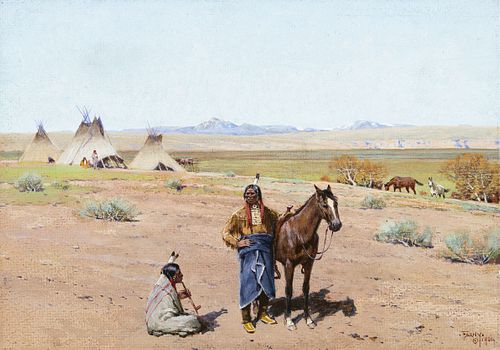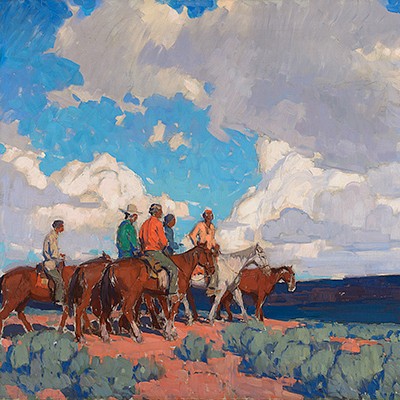Henry Farny (1847–1916) — A Sioux Camp (1901)
Lot 37
About Seller
Coeur d'Alene Art Auction
11944 North Tracey Road
Hayden, ID 83835
United States
Coeur d’Alene Art Auction specializes in the finest classical Western and American Art representing past masters and outstanding contemporary artists. The auction principals have over 100 years of combined experience in selling fine art and have netted their clients over $325 million in the last fif...Read more
Categories
Estimate:
$150,000 - $250,000
Absentee vs Live bid
Two ways to bid:
- Leave a max absentee bid and the platform will bid on your behalf up to your maximum bid during the live auction.
- Bid live during the auction and your bids will be submitted real-time to the auctioneer.
Bid Increments
| Price | Bid Increment |
|---|---|
| $0 | $100 |
| $2,000 | $250 |
| $5,000 | $500 |
| $10,000 | $1,000 |
| $20,000 | $2,500 |
| $50,000 | $5,000 |
| $100,000 | $10,000 |
| $200,000 | $25,000 |
| $500,000 | $50,000 |
| $1,000,000 | $100,000 |
About Auction
By Coeur d'Alene Art Auction
Jul 23, 2022
Set Reminder
2022-07-23 15:00:00
2022-07-23 15:00:00
America/New_York
Bidsquare
Bidsquare : Fine Western & American Art
https://www.bidsquare.com/auctions/coeur-dalene/fine-western-american-art-9644
The 2022 Coeur d’Alene Art Auction to be held July 23 in Reno, Nevada, will feature 333 selections of unparalleled quality in Western paintings and sculpture from historical and contemporary artists such as Charles M. Russell, Edgar Payne, W. Herbert Dunton, Frederic Remington, and more. Coeur d'Alene Art Auction info@cdaartauction.com
The 2022 Coeur d’Alene Art Auction to be held July 23 in Reno, Nevada, will feature 333 selections of unparalleled quality in Western paintings and sculpture from historical and contemporary artists such as Charles M. Russell, Edgar Payne, W. Herbert Dunton, Frederic Remington, and more. Coeur d'Alene Art Auction info@cdaartauction.com
- Lot Description
Henry Farny (1847–1916)
A Sioux Camp (1901)
gouache on paper
7 × 10 inches
signed and dated lower right
A Sioux Camp is an outstanding example of Farny’s work and demonstrates his brilliance both as a landscape painter and historian as he pictures the starkness of the Dakota Territory. In many of his most successful paintings, Farny employed a progression of horizontal planes to achieve a sense of receding depth. The figures in the foreground anchor the painting, with a line of teepees and trees in the middle foreground, and a horizontal line of mountains in the distance. The sparse landscape and the quiet solitude of the plains are expertly captured in this composition.
Farny made several trips to the West in his pursuit of knowledge of the tribes of the American frontier. He learned two Indian languages and was adopted by the Senecas, the Sioux, the Blackfeet, and the Zuni. Throughout his career he had remarkable encounters with historical figures and events: Farny introduced Sitting Bull to General Ulysses S. Grant in 1883, he sketched Geronimo, and he witnessed firsthand the Ghost Dance of the Sioux.
Farny’s paintings were not glorified images of the Wild West. Instead, he created intimate, realistic depictions of Native Americans, their customs, and their disappearing way of life.
Theodore Roosevelt wrote, “The nation owes you [Farny] a great debt. It does not realize now, but it will someday. You are preserving for future generations phases of American history that are rapidly passing away.”
PROVENANCE
The artist
Harry S. Leyman, Cincinnati, Ohio, 1901
Private collection, by descent
EXHIBITED
Henry F. Farny and the American Indian, Cincinnati Art Museum, Cincinnati, Ohio, 1943
View more informationAs viewed through glass. Paper appears to be in good condition.Condition
- Buyer's Premium



 EUR
EUR CAD
CAD AUD
AUD GBP
GBP MXN
MXN HKD
HKD CNY
CNY MYR
MYR SEK
SEK SGD
SGD CHF
CHF THB
THB













